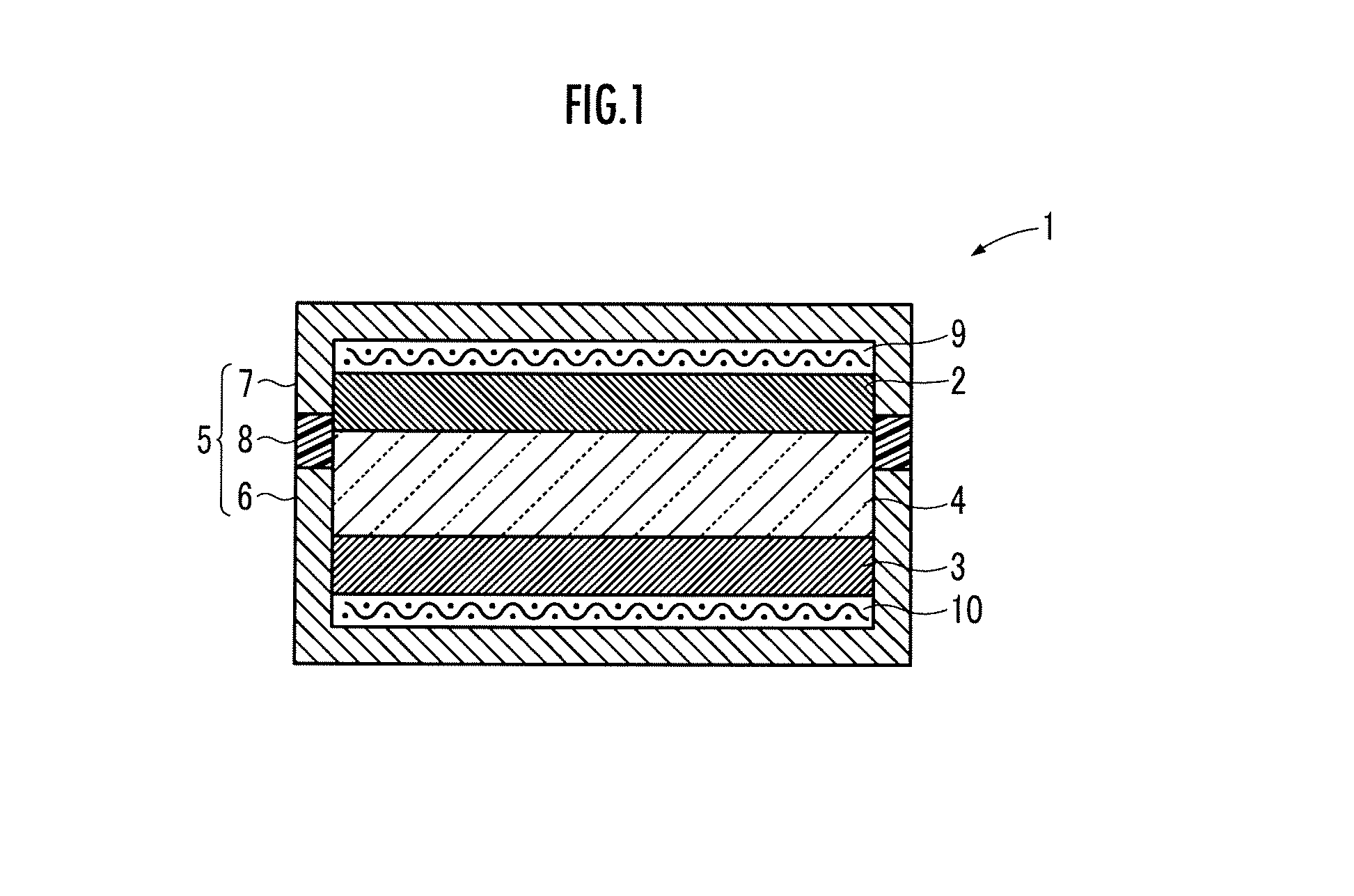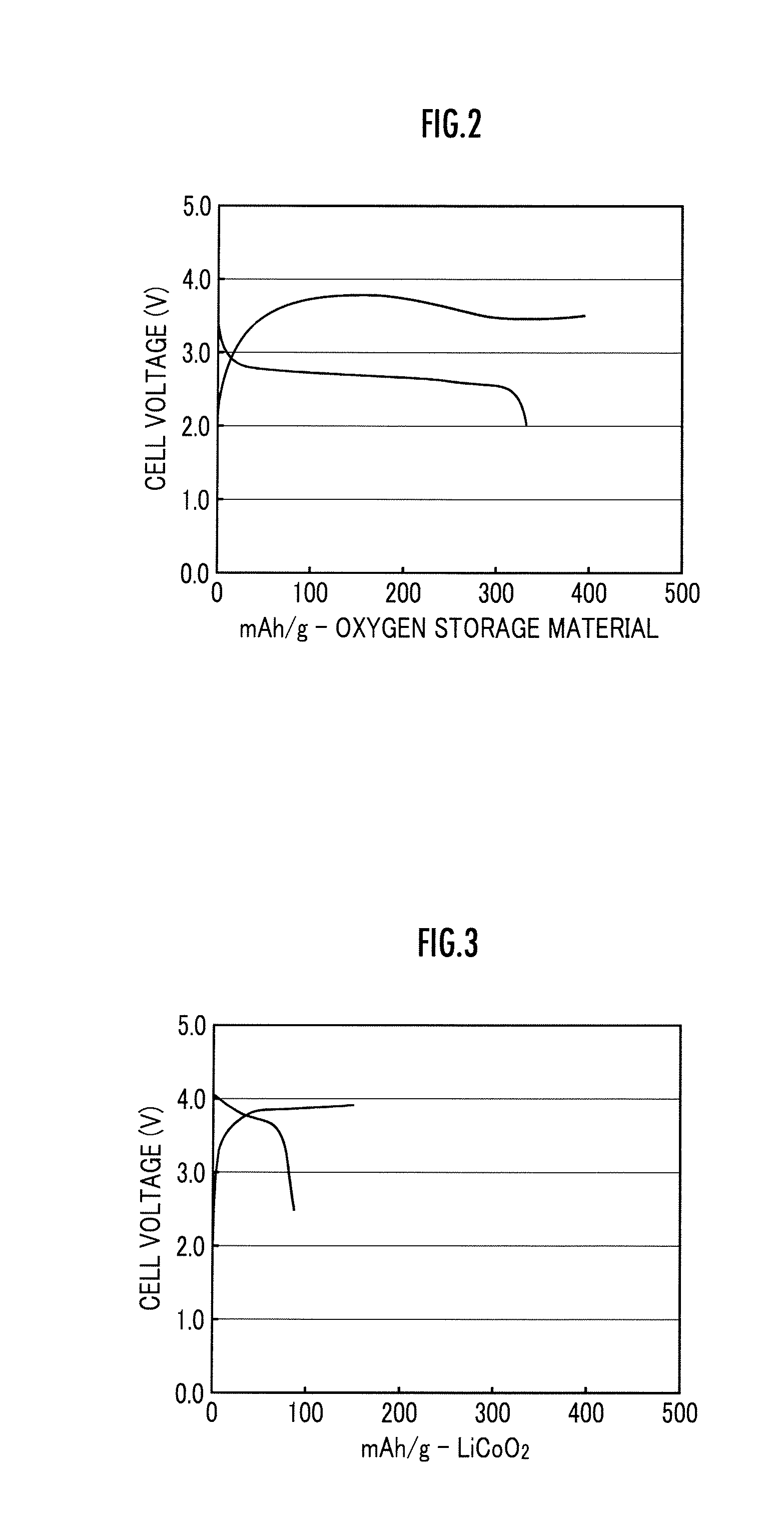Lithium ion oxygen battery
a technology of oxygen battery and lithium ion, which is applied in the direction of fuel and primary cells, cell components, electrochemical generators, etc., can solve the problems of insufficient increase of energy density per mass and less maintenance of cobalt oxide, so as to reduce reaction rate, reduce overvoltage, and reduce energy
- Summary
- Abstract
- Description
- Claims
- Application Information
AI Technical Summary
Benefits of technology
Problems solved by technology
Method used
Image
Examples
example 1
[0072]In the present Example, firstly, yttrium nitrate pentahydrate, manganese nitrate hexahydrate, and malic acid were pulverized and mixed at a molar ratio of 1:1:6 to obtain a material mixture for a combined metal oxide. Next, the obtained material mixture for a combined metal oxide was reacted at a temperature of 250° C. for 30 minutes, and furthermore, at a temperature of 300° C. for 30 minutes and at a temperature of 350° C. for 1 hour. Then, after pulverizing and mixing a mixture of a reaction product, the mixture was calcined at a temperature of 1000° C. for 1 hour to obtain a combined metal oxide represented by a chemical formula YMnO3.
[0073]Next, 40 parts by mass of the obtained YMnO3, 50 parts by mass of Ketjen Black (manufactured by Lion Corporation) as a conductive material, 10 parts by mass of polytetrafluoroethylene (manufactured by Daikin Industries, Ltd.) as a binding agent, and furthermore 80 parts by mass of lithium peroxide (manufactured by Kojundo Chemical Labor...
example 2
[0085]In the present Example, firstly, the combined metal oxide represented by the chemical formula YMnO3 was obtained in the same manner as in Example 1. Next, the obtained YMnO3 was reduction-treated at a temperature of 300° C.
[0086]Next, 80 parts by mass of the reduction-treated YMnO3, 8 parts by mass of Ketjen Black (manufactured by Lion Corporation) as a conductive material, 2 parts by mass of vapor grown carbon fiber (VGCF, manufactured by Showa Denko K.K.) as a conductive material, 10 parts by mass of polyvinylidene fluoride (manufactured by Kureha Corporation) as a binding agent, and 80 parts by mass of lithium peroxide (manufactured by Kojundo Chemical Laboratory Co., Ltd.) as a lithium compound were dispersed in 600 parts by mass of N-methyl-2-pyrrolidone to be mixed. The obtained mixture was applied to the positive electrode current collector 9 made of an aluminum mesh (manufactured by Clever Co., Ltd.) and dried to form the positive electrode 2 having a diameter of 15 mm...
example 3
[0094]In the present Example, firstly, the combined metal oxide represented by the chemical formula YMnO3 was obtained in the same manner as in Example 1. Next, the obtained YMnO3 was reduction-treated at a temperature of 300° C.
[0095]Next, 40 parts by mass of the reduction-treated YMnO3, 30 parts by mass of Ketjen Black (manufactured by Lion Corporation) as a conductive material, 30 parts by mass of an acrylic resin (manufactured by Zeon Corporation) as a binding agent, and 40 parts by mass of lithium peroxide (manufactured by Kojundo Chemical Laboratory Co., Ltd.) as a lithium compound were dispersed in 500 parts by mass of N-methyl-2-pyrrolidone to be mixed. The obtained mixture was applied to the positive electrode current collector 9 made of an aluminum mesh (manufactured by Clever Co., Ltd.) and dried to form the positive electrode 2 having a diameter of 15 mm and a thickness of 0.5 mm
[0096]Next, 90 parts by mass of graphite (manufactured by Kureha Corporation) as a carbon mat...
PUM
| Property | Measurement | Unit |
|---|---|---|
| temperature | aaaaa | aaaaa |
| temperature | aaaaa | aaaaa |
| temperature | aaaaa | aaaaa |
Abstract
Description
Claims
Application Information
 Login to View More
Login to View More - R&D
- Intellectual Property
- Life Sciences
- Materials
- Tech Scout
- Unparalleled Data Quality
- Higher Quality Content
- 60% Fewer Hallucinations
Browse by: Latest US Patents, China's latest patents, Technical Efficacy Thesaurus, Application Domain, Technology Topic, Popular Technical Reports.
© 2025 PatSnap. All rights reserved.Legal|Privacy policy|Modern Slavery Act Transparency Statement|Sitemap|About US| Contact US: help@patsnap.com



